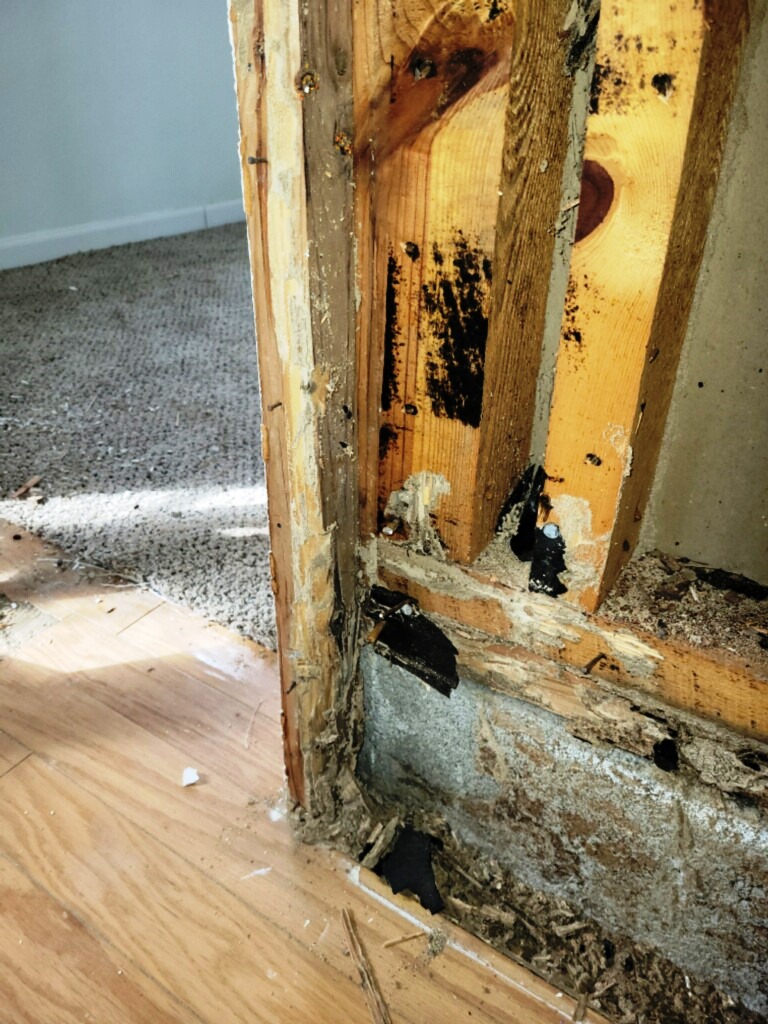It happens. Termites can quickly get out of control and chew up supportive structures within the walls. Over time, you might remove the drywall and see something like this:

Termite Damage Facts
- Each year termites damage about 600,000 homes in the U.S.
- That damage costs about $5 billion to repair, all in
- Homeowner’s insurance quite often does not cover repairs for termite damage
- Termites can consume as much as 3% of their body weight in one day
We recently completed a guest house remodel project that involved extensive termite damage. (You can watch the before and after video on our Instagram account here.)
The project involved stripping down the walls to the studs to examine the full extent of the damage, and reworking the plumbing, electrical, and HVAC system as well.
In the end, the guest house was remodeled into a beautiful, modern space with a new kitchen and bathroom, complete with tile shower. New windows were added throughout, and the front door was replaced with a striking red color against the front of the building.
Studies Show Termite Infestations Could Be Getting Worse
A 2017 study on global termite infestations and climate changes showed that environmental degredation and climate changes does create opportunities for invasive species like termites to spread into residential areas.
Worse yet, two different species (C. formosanus and C. gestroi), both of which are a huge problem in areas like Florida, have begun mating and hybridizing. The result is a new hybrid species that reproduces at twice the rate of previous varieties of termites.
The study forecasts that Mastotermes darwiniensis, widely considered the most destructive breed of termite in the world, will increase in overall prevalence by 55%-85% globally.
To a degree, the study points out, this issue builds upon itself and worsens the situation because termites also emit significant amounts of methane as they consume wood structures, and the increased methane emissions contribute to climate change — the same climate change that is already causing them to spread.
Study Citation:
Buczkowski G, Bertelsmeier C. Invasive termites in a changing climate: A global perspective. Ecol Evol. 2017 Jan 15;7(3):974-985. doi: 10.1002/ece3.2674. PMID: 28168033; PMCID: PMC5288252.
Signs of a Termite Infestation In Your Home:
- Wood that sounds hollow if you tap on it
- Blistering paint
- Ceiling that look like they are sagging or buckling
- Muddy areas on walls near the foundation
- Wooden surfaces that are soft or squishy to the touch
- Ongoing musty odors
Termite Resistant Building Materials
Whether building a new home or remodeling/repairing an existing one, there are a few types of building materials that are naturally termite-resistant.
That means termites aren’t generally attracted to these materials, and the chances will be better of avoiding future infestations. Further, if termites do visit your home the damage will be less severe.
Some types of wood are naturally resistant to termites, such as cedar, redwood, and even cypress. A more common and widely available alternative is pressure treated lumber.
Beyond that, building with cement, stone, and brick is also a pretty surefire way to avoid termites. Vinyl siding can also add a layer of protection against termites.
Typical Costs of Termite Damage Repair
The size of your home and the extent of the damage will affect the cost, of course. Generally speaking though, costs average $1000-3000 for the repairs themselves.
The project we spoke of earlier on in this post was obviously more because there was extensive remodeling going on alongside the termite repairs.

